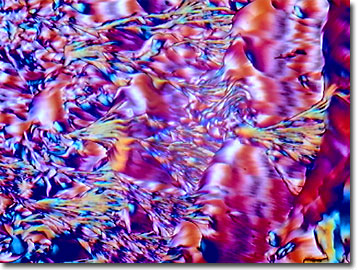Polarized Light Digital Image Gallery
Riboflavin (Vitamin B-2)
Riboflavin, also known as vitamin B-2, is a water-soluble vitamin that promotes normal growth, facilitates the breakdown of fat, and aids the syntheses of steroids, red blood cells, and glycogen. Natural sources of vitamin B-2 include almonds, yeast, cheese, eggs, chicken, beef, organ meats, and wheat germ.

View a second image of riboflavin.
Synthesized riboflavin is available as a dietary supplement or is found in vitamin-enriched foods, such as skim milk and breakfast cereals, and is featured in animal feeds. Activation of vitamin B-6 and folic acid require riboflavin, and the vitamin is helpful in the treatment of cataracts and other eye disorders. Symptoms associated with riboflavin deficiency are inflammation of the tongue, light sensitivity, itching, dizziness, insomnia, and slow learning.
Named from the Latin word flavius (yellow) to denote the rich color of crystals formed from the pure vitamin and the deep yellow color it gives to urine, riboflavin was formerly known also as lactoflavin or vitamin G. Biochemically, riboflavin is metabolized to form the flavin coenzymes: flavin adenine dinucleotide (FAD) and flavin mononucleotide (FMN). The functional moiety in both coenzymes is riboflavin's isoalloxazine ring system, which serves as a two-electron acceptor in enzymatic biochemical reductions. Enzymes that use a flavin cofactor are termed "flavoproteins" and have been extensively studied.
On an industrial scale, riboflavin is manufactured via biosynthesis using yeast or other fermenting organisms, and it is used as a yellow coloring agent and for vitamin fortification of foods such as cereals, sauces, vitamin supplements, and soups. However, it is difficult to incorporate into most food products because of it insolubility in water and thus, the more expensive, but water-soluble derivative, riboflavin-5'-phosphate is often used in milk products, jams, and sugar products. Upon ingestion, this chemically prepared supplement and dye converts to free riboflavin.
Contributing Authors
Omar Alvarado, Thomas J. Fellers and Michael W. Davidson - National High Magnetic Field Laboratory, 1800 East Paul Dirac Dr., The Florida State University, Tallahassee, Florida, 32310.
BACK TO THE POLARIZED LIGHT IMAGE GALLERY
BACK TO THE DIGITAL IMAGE GALLERIES
Questions or comments? Send us an email.
© 1995-2025 by Michael W. Davidson and The Florida State University. All Rights Reserved. No images, graphics, software, scripts, or applets may be reproduced or used in any manner without permission from the copyright holders. Use of this website means you agree to all of the Legal Terms and Conditions set forth by the owners.
This website is maintained by our
Graphics & Web Programming Team
in collaboration with Optical Microscopy at the
National High Magnetic Field Laboratory.
Last Modification Friday, Nov 13, 2015 at 01:19 PM
Access Count Since September 17, 2002: 13090
Visit the website of our partner in introductory microscopy education:
|
|
